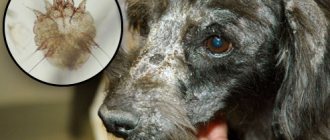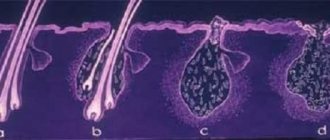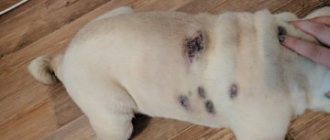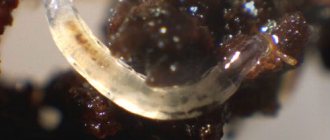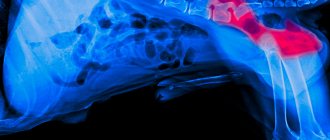Skin diseases in pets are a fairly common phenomenon in veterinary medicine. The pet may have mechanical damage, various viral or fungal diseases. Scabies is very often diagnosed. Treatment of sarcoptic mange in dogs, or more simply put, scabies caused by skin mites, is the topic of our article.
What is sarcoptic mange
The causative agents of sarcoptic mange are mites Sarcoptes scabiei var. canis or scabies. These are small arthropods measuring 0.2 - 0.5 mm in size that live and reproduce in the thickness of the epidermis. Parasites feed on lymph and skin particles, gnawing out tunnels with ventilation outlets to the surface with their mouth appendages.
The biological cycle of Sarcoptes canis lasts from 15 to 19 days and goes through 5 stages of development: egg, larva, protonymph, teleonymph, imago.
Sexually mature females live 1.5 months. Moving through the tunnel, they lay 2–6 eggs at a time, up to 60 throughout the entire period. Males live in the epidermis for up to 1 month, and die after mating.
On the surface of the skin, Sarcoptes canis moves at a speed of 3 cm/min, in the epidermis - 2.5 mm per day. Over the course of its entire life, the itch gnaws a canal about 6 cm long.
In the external environment, the scabies mite lives for 6 days, at a favorable temperature of 10 - 15℃ and high humidity - up to 3 weeks. The eggs remain viable for up to a month. At temperatures below 0℃ and above 21℃, parasites quickly die. The video shows a magnified scabies mite.
Dogs often suffer from scabies, regardless of season, gender, age and breed. Animals are affected only by teleonymphs and sexually mature females. The source of infection is sick dogs and common care items - bedding, combs, towels. It is less common to catch a tick in a room where an infected dog has been.
Precautionary measures
Although sarcoptic mange is highly contagious, not all dogs that come into contact with an infected animal will develop pruritic mange, and some dogs may remain asymptomatic carriers and spreaders of the disease without showing any clinical signs. Due to this circumstance, it is necessary to carry out antiparasitic treatments on all dogs in contact.
Since canine pruritic mange is a disease common to animals and humans, rubber gloves must be used when treating a sick dog to avoid itching and skin lesions.
Due to the fact that the tick survives outside the dog for less than 2 weeks, environmental treatment in most cases is not required, however, it is necessary to isolate the sick animal and provide separate care items for the duration of treatment. If necessary, combs, brushes and collars can be treated with boiling water.
Is sarcoptic mange contagious to the owner?
A person is attacked by another type of scabies mite. However, if there is close contact with an infected pet, canine itch can spread to the owner and cause pseudosarcoptosis.
Only the larvae spread to humans. When they get on the skin, they sink under the keratinized scales of the epidermis, into the hair follicles and cause an inflammatory reaction. In places where there is frequent contact with the pet, bright red or pink itchy spots, rashes, and blisters appear.
Itchy rash on the skin with the development of pseudosarcoptosis.
However, human skin is not suitable for life and reproduction of dog itch. They do not penetrate the epidermis, do not dig tunnels, and do not lay eggs. Before reaching the stage of sexual maturity, the larvae are rejected and die.
Pseudosarcoptosis is not transmitted to another person and does not require treatment. Redness and itching disappear spontaneously when the dog recovers.
Sometimes a dog suffers from sarcoptic mange without obvious symptoms, and the owner develops pseudoscabies. In this case, the appearance of a rash, spots, and itching in areas of contact with the dog indirectly signal the development of sarcoptic mange.
Pathogen
The causative agent is the mite Sarcoptes Canis. The site of parasitism is the skin of the animal. The type of infection is contagious (during contact with a sick dog). Female parasites cause maximum harm. The reason is the ability to make holes in the skin and lay eggs. The method of nutrition is the consumption of liquid found in the tissues of the animal. Sarcoptic mange is a contagious disease. In the chronic stage, the likelihood of a successful outcome is minimized. Making a diagnosis at an early stage and timely contacting a veterinarian is the key to positive treatment.
Pathogenesis
Places where the dangerous parasite is localized are the bends of the elbows, joints, and ears. A sign of localization is the absence of dense vegetation.
Time for symptoms of the disease to appear: the second or third week after the tick gets on the skin. The next stage is the progression of the parasite throughout the pet’s body. In warm rooms, ear mites become more active and cause allergic reactions. The lack of therapeutic measures leads to the transition of the disease to a chronic form.
Take the Attention Test! Find 10 differences! (click right here!)
Find the answer Are you bothered by some problem or question? Enter “Breed” or “Name of the problem” into the form, press Enter and you will find out everything about the issue that interests you.
Diagnostics
Algorithm for carrying out diagnostic measures:
- Taking a skin scraping;
- Examination of material under a microscope (identification of eggs and parasites).
Taking a skin test at the site of recent scratching is a way to make an accurate diagnosis in animals. The research material should not contain dog salivary secretions.
Establishing diagnosis
Similar diseases: atopy, dermatitis, folliculitis. The main difference with sarcoptic mange is itching in dogs. Steroid drugs do not eliminate the unpleasant symptom. If an erroneous diagnosis is made, the veterinarian changes the therapy.
Symptoms of sarcoptic mange in dogs
The clinical picture of the disease depends on the individual immuno-allergic reaction to saliva and parasite excrement. Therefore, symptoms do not appear from the moment of infection, but after sensitization - the development of sensitivity to allergens and irritants.
The first symptoms of sarcoptic mange appear after 1 to 3 weeks. With repeated infection, the disease manifests itself much faster – within 1–3 days.
Scabies mites love to live in areas with short hair. The first outbreaks most often occur:
- on the back of the nose;
- around eyes;
- eyebrows;
- along the edges of the ears;
- on the elbow and hock joints;
- on the stomach;
- in the groin;
- armpits.
Damage to the ear.
Here are the main signs of infection:
- The main symptom of sarcoptic mange is increasing itching. It occurs in response to parasite bites and as an allergic reaction to excrement, eggs, and saliva. The dog chews, licks places where parasites accumulate, and begins to itch even where there are no ticks. The itching intensifies in the evening and at night, in warm rooms, near heating devices.
- The animal develops an ear-pedal reflex. If you rub the tip of the ear between your fingers, the dog involuntarily jerks its back paw, as if trying to scratch its ear.
- In places where itching accumulates, the skin first turns red and then becomes covered with nodules. The fur falls out and thins.
Scabies on the abdomen: nodules, redness.
- The nodules turn into blisters with clear inflammatory exudate. Due to severe itching, the dog leaves scratches and abrasions on the skin, and injures blisters.
Consequences of scratching with severe itching.
- The released liquid sticks the hair together, then dries and turns into crusts and scabs.
Redness, crusts, baldness on the elbow.
- In places where severe scratching occurs, the skin becomes rough and thick, hair falls out, up to complete baldness.
Damage to paws with scabies.
- Sometimes the skin peels over the entire surface, and dandruff appears.
- In advanced cases, a bacterial infection spreads in places where scratching occurs, and ulcers with an unpleasant odor appear.
- Against the background of general intoxication, the temperature sometimes rises and the lymph nodes become inflamed.
- Behavior changes due to exhausting itching. The dog becomes irritated or apathetic, loses appetite, and loses weight.
Animals with a weak immuno-allergic reaction and older dogs often tolerate sarcoptic mange without itching.
Sarcoptic lesion on the bridge of the nose without itching.
Why are fleas dangerous?
The most common problem associated with flea bites is flea allergic dermatitis (FAD), manifested by itching, excessive shedding, hair loss and even baldness. Dogs suffering from itching become less obedient and irritated.
A common complication of flea allergy dermatitis is pyoderma, a bacterial skin infection in which the skin may become red, moist, sticky, crusty, and pustular.
Treatment of a bacterial infection can be lengthy, and bacteria may develop resistance to antibiotics. Small dogs may develop anemia (anemia) due to constant blood loss associated with feeding on a large number of fleas. There is evidence that up to 700 fleas were found on one dog! In addition, fleas are carriers of the helminth – cucumber tapeworm (Dipylidium caninum), which develops in the small intestine of animals (including dogs and cats) and humans. Infection occurs through accidental ingestion of infected fleas and their larvae. Small children who play on the floor in a room with a flea-infested dog are often infected.
Diagnostics
Sarcoptic mange is diagnosed based on clinical presentation, microscopic analysis of skin scrapings, and trial treatment.
It is not always possible to make an accurate diagnosis based on external signs, since the symptoms of scabies resemble other skin pathologies:
- atopic, flea, contact dermatitis;
- food allergies;
- demodicosis;
- superficial pyoderma;
- cheyleliosis;
- dermatophytosis;
- notoedrosis.
To clarify the diagnosis, a microscopic analysis is prescribed. Numerous superficial scrapings are taken from the dog from typical areas of scabies. The diagnosis is confirmed when mites, larvae, eggs, and excrement are found under a microscope. However, traces of parasites can be detected in only half of the dogs; according to other sources, in 20%.
An adult scabies itch under a microscope.
If the tests show a negative result, and the clinical picture of sarcoptic mange is obvious, then a trial treatment is prescribed. The diagnosis is confirmed when anti-tick therapy helps alleviate the symptoms and the dog is on the mend.
Before visiting the veterinarian and taking scrapings, the pet is not washed, treated with anything, or given any medications.
How to distinguish it from other diseases
Dogs can also be affected by other subcutaneous mites: demodex and otodex. Also, some symptoms resemble signs of fungal and other skin diseases (microsporia, trichophytosis, dermatitis, pyoderma, etc.).
The disease has one striking symptom - severe itching, which is not present in demodicosis and some skin diseases. The difference between otodectosis is that mites are localized only in the ear canals.
The only accurate way to distinguish sarcoptic mange is by taking deep scrapings of the affected areas of the skin.
How to treat sarcoptic mange in dogs and puppies
The treatment regimen for scabies includes:
- Shampoos with a keratolytic, antiseptic effect for disinfection, softening and cleansing of the skin from crusts, scales, scabs.
- Acaricidal agents for the destruction of itches. Solutions for local treatments and drip application to the withers, ointments, and concentrates are produced against scabies mites. In difficult cases, systemic medications are prescribed - tablets, injection solutions.
Additionally you may need:
- Antipruritic for severe scratching.
- Antibiotics for the appearance of suppuration.
If several animals live in the house, the sick dog is isolated. The rest also undergo treatment, even if there are no visible symptoms of infection.
Shampoos
Veterinary shampoos for removing crusts.
Before applying acaricidal preparations, the animal is completely bathed with a keratolytic detergent, for example:
- Doctor cleansing. Shampoo with benzoyl peroxide. This synthetic substance softens rough skin, exfoliates keratinized scales and crusts, and inhibits pathogenic microflora.
- DermaBenSs. Therapeutic shampoo for bathing pets with bacterial, parasitic skin diseases, scratching. The composition is enriched with benzoyl peroxide, 1% sulfuric acid, salicylic acid, which disinfect and dry the skin.
- Peroxiderm. Antibacterial agent with benzoyl peroxide.
Lather the shampoo on wet wool and leave for 5 – 7 minutes. The crusts are first soaked, then those that come off easily are removed.
At the end, the shampoo is washed off with running water, and the pet is rinsed with a decoction of medicinal plants: chamomile, celandine or calendula. After bathing, the fur is carefully blotted with a towel so as not to transfer parasites to healthy parts of the body.
Acaricidal ointments, solutions
Before treatment, the hair from the affected area and around the lesion is cut off. The dog is put on a veterinary collar or muzzle. The preparations are rubbed from the borders of the affected area to the center, covering 2–4 cm of healthy skin.
Here are examples of effective external remedies against scabies mites:
- Aversectin ointment. The main component is the acaricide aversectin C. Treatments are repeated 2–5 times every 5–7 days. The ointment is contraindicated in puppies under 8 weeks of age, during pregnancy, and while nursing offspring. A similar drug is Amidel gel. It is allowed for puppies from 2 weeks of age.
- Decta Forte. Combined solution based on 3 components. Fipronil destroys mites, chloramphenicol blocks the spread of pathogenic bacteria, lidocaine reduces sensitivity. The animal is treated 2–5 times at intervals of 5 days. Decta is not recommended for treating puppies under 4 weeks of age, pregnant or lactating females. Similar solutions: Amitrazine, Amit Forte.
- Simple sulfur, sulfur-tar ointment. The drugs stop the spread of ticks, accelerate tissue regeneration, and stimulate hair growth. Treatments are carried out daily 1 - 2 times a day until the epidermis is restored. There are no contraindications based on age. Both ointments can be combined with other drugs.
Emulsion concentrates
Emulsion concentrates against scabies mites.
Concentrates based on synthetic insectoacaricides work well against arthropod parasites:
- Butox;
- Neostomozan;
- Delcid.
For dogs and cats, the liquid is poured into glass ampoules in a volume of 1 to 5 ml. Concentrates are diluted with water according to the instructions immediately before processing. Rub the prepared solution with a sponge into the skin and fur over the entire surface.
After treatment, the liquid is not washed off and the animal is not wiped. The muzzle can be removed when the coat is dry. The solution is applied 2 - 3 times every 7 - 10 days. The prepared aqueous emulsion is stored for no longer than 2 hours.
Drops on the withers
Spot-on solutions are effective against scabies mites. Drops are applied pointwise to intact dry skin in places where the dog cannot lick them off - at the base of the neck, between the shoulder blades.
Solutions are produced in pipettes with a dose of the active substance already calculated based on body weight, so the pet is weighed before choosing drops.
Here are examples of effective solutions for the withers to destroy itch mites:
- Stronghold. Drops with selamectin. To treat scabies, the dog is treated twice with a 1 month interval. The drug is allowed from 6 weeks of age.
- Advocate. The drops combine 2 potent insectoacaricides: moxidectin and imidacloprid. When treating scabies, the solution is applied 2 times with a time interval of 30 days. Puppies can be treated from 7 weeks, miniature dogs weighing less than 1 kg - only with the permission of the treating veterinarian.
- Bravecto Spot On. Drops based on fluralaner. To destroy sarcoptic mites, one treatment is enough. Drops are not used for animals younger than 8 weeks and lighter than 2 kg.
Pills
Tablets for the treatment and prevention of sarcoptic mange.
Relatively recently, tablets began to be produced to combat ticks. They are relatively safe for mammals, and they are good at treating parasitic diseases: sarcoptic mange, demodectic mange, and otodectic mange.
Preparations are selected strictly according to the weight of the animal after weighing; they cannot be crushed or broken. Tablets are given by hand or with food. For picky pets they hide it in a piece of meat.
- Nexguard Spectra. The active ingredient is afoxolaner. For sarcoptic mange, feed 1 tablet, after 30 days another one. Nexgard Spectra is contraindicated in small dogs lighter than 2 kg. A similar drug is Frontline Nexgard.
- Simparica. A drug based on sarolaner. When treating scabies, 2 doses of 1 tablet are prescribed with a break of 1 month. The permissible body weight limit is lower than that of other tablets - 1.3 kg.
- Bravecto. To eliminate scabies, 1 tablet of the required dosage is enough. The next one can be given for prevention after 12 weeks.
Anti-mite tablets should not be used on puppies under 8 weeks of age.
Injections
For extensive lesions, injectable drugs of the avermectin series are prescribed:
- Aversect K&S. They produce 2 types with different concentrations of the active component aversectin C: 0.2% for cats and dogs weighing up to 10 kg, 0.5% for dogs weighing more than 10 kg. For sarcoptic mange, injections are given 2 times with a week's break, following the dosage according to the instructions.
- Otodectin. Ivermectin based solution. It is administered subcutaneously twice with an interval of 8–10 days at the rate of 0.2 ml per 1 kg of body weight.
Both drugs are not approved for puppies under 2 months, animals with kidney or liver diseases. Due to breed sensitivity, avermectins are poorly tolerated by bobtails, collies, and shelties.
Preparations for itching
The itching can be so severe that the dog scratches itself until it bleeds, and bacteria and fungi quickly spread to open wounds. Therefore, in case of unbearable itching, drugs that suppress the immuno-allergic reaction are prescribed.
Apoquel. They produce 3 types with different contents of the active component oclacitinib for small, medium, and large dogs. The tablets are fed with food or by hand twice a day. Single dose 0.4 – 0.6 mg/1 kg. The instructions contain a detailed dosage table by body weight.
The duration of admission is determined individually according to the condition of the animal, but no longer than 14 days. The medicine is safe when taken for a short time. Apoquel is prohibited for puppies under 1 year of age, mini dogs lighter than 3 kg, during pregnancy, and for malignant neoplasms.
Prednisolone or veterinary analogue Prednivet. The medicine is administered subcutaneously for 3 to 5 days during the period of exacerbation of itching. The average daily dose of prednisolone for dogs is 0.5 – 1 mg per kg of weight. According to reviews from owners, prednisolone does little to relieve itching caused by scabies mites.
Antibacterial drugs
A bacterial infection often develops at the site of scratching and suppuration occurs. In this case, external antiseptics or antibiotics are prescribed:
- Amoxicillin 15%, veterinary. Suspension for injection. The medicine is administered subcutaneously or intramuscularly 1 time. If there is no noticeable improvement, a second injection is given after 48 hours. According to the instructions, a single dose of amoxicillin is 15 mg/1 kg, which is 1 ml of suspension per 10 kg of body weight.
Amoxicillin veterinary.
- Sinulox. Injectable suspension and tablets containing a combination of amoxicillin and clavulanic acid. Injections are given into the muscle or under the skin for 3–5 days, once a day. 1 ml of suspension is designed for 20 kg of body weight, so for injections it is better to take an insulin syringe. Sinulox tablets are given twice a day at the rate of 12.5 mg/1 kg. The course of treatment for skin infections lasts from 1 to 4 weeks. The “human” analogue of Sinolox is Amoxiclav tablets.
Sinulox suspension and tablets.
The veterinarian can adjust the dose of the antibiotic and the duration of the course depending on the dog’s condition.
Prevention
Preventive actions:
- Treating your dog's belongings after a walk with anti-parasite medications.
- A ban on dogs playing with stray animals. If contact occurs, treatment is carried out with a solution of 2 percent chlorophos.
- Wearing an anti-parasite collar. The device does not act on ticks.
- Undergoing a routine examination by a veterinarian. Produced once every 6 months.
- Disinfection of the pet's bedding, periodic replacement of the bed.
- Prevention of scabies.
- Washing with shampoos (have acaricidal properties).
Regular examination of your dog is a guarantee of timely detection of various diseases. Activities increase the life expectancy of your pet.
Forecast
Sarcoptic mange is debilitating for a dog and does not go away spontaneously, but is highly treatable. The prognosis is favorable.
It will take 4 to 8 weeks to completely eliminate itching and restore skin and fur. However, noticeable improvement occurs within the first 14 days. The rate of recovery depends on the size of the lesion, the severity of the lesion, and the animal’s immunity.
If after 6 weeks from the start of treatment there are no noticeable improvements, the itching does not go away, additional studies are prescribed to determine the real cause of the disease.
Infection with scabies can be avoided if you keep your pet away from dogs with obvious signs of sarcoptic mange and use anti-mite means: drops on the withers, collars or tablets.
Question answer
Is sarcoptic mange dangerous for humans?
If there is a sick dog in the house, all family members, especially children and allergy sufferers, should be excluded from contact with it. Sarcoptic mange in dogs can provoke a pathology such as pseudosarcoptosis in humans. Ticks, when they get on human skin, do not penetrate inside, but bite on its surface, causing itching, allergic reactions and various types of eczema. The disease is not transmitted from person to person. It often heals on its own; in rare cases, it is necessary to resort to local specific therapy.
How long does it take to treat sarcoptic mange?
The duration of treatment directly depends on the state of the dog’s immune system, as well as the degree of tick infestation. The weaker the animal and the longer it has been without treatment, allowing the tick to multiply and spread throughout the body, the longer the therapy will last. On average this can take from 2 to 8 weeks. In rare cases, treatment takes longer.
Is treatment possible at home?
When fighting sarcoptic mites, you should not resort to self-medication. You should strictly follow the veterinarian's instructions. The use of traditional medicine recipes is allowed, but only as auxiliary therapeutic agents and only after consultation with a specialist.
What should be distinguished from sarcoptic mange?
Sarcoptic mange occurs almost identically with demodicosis and notoedrosis. Each of these diseases is caused by intradermal mites of its own type, but the differences in symptoms are very, very insignificant. Only a specialist can tell exactly what a dog has by performing a microscopy of a skin scraping. Detecting a tick is not so easy, but its absence in a sample does not mean that the dog is not infected with a tick, because No one has canceled the classic symptoms. Often the diagnosis is already made after diagnostic treatment, i.e. anti-tick therapy begins, which gives an appropriate response from the body in the form of a cure.
It is important to note that you don’t have to delve too deeply into the processes of differentiation of subcutaneous mites among themselves. The mite that causes sarcoptic mange in dogs is killed with the same drugs that kill demodicosis and notoedrosis. The frequency and duration of treatment differ somewhat, but this can always be adjusted as therapy progresses.
Author:
Grinchuk Ekaterina Andreevna veterinarian
